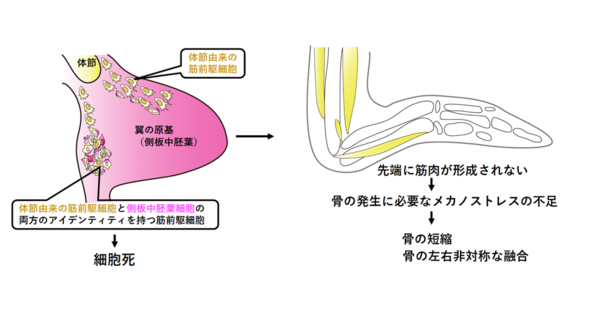- HOME
- News & Events
- Publications
- 【Publications】Immobilization secondary to cell death of muscle precursors with a dual transcriptiona...
Publications
【Publications】Immobilization secondary to cell death of muscle precursors with a dual transcriptional signature contributes to the emu wing skeletal pattern
September 20 2024
Lab: Guojun Sheng
Paper information
Title:
Immobilization secondary to cell death of muscle precursors with a dual transcriptional signature contributes to the emu wing skeletal pattern
Eriko Tsuboi, Satomi F. Ono, Ingrid Rosenburg Cordeiro, Reiko Yu, Toru Kawanishi, Makoto Koizumi, Shuji Shigenobu, Guojun Sheng, Masataka Okabe & Mikiko Tanaka
Nature Communications September 19 2024 doi: https://doi.org/10.1038/s41467-024-52203-x
URL: https://www.nature.com/articles/s41467-024-52203-x
Highlights
- Emus are flightless birds, with vestigial wings and shortened and reduced number of wing digits (fingers);
- Emu wing muscle progenitors have mixed origins and die before proper distal migration, and absence of distal muscle leads to skeletal shortening, fusion and left-right asymmetry
- Tissue crosstalk is important for tissue maturation in development
Abstract:
Limb reduction has occurred multiple times in tetrapod history. Among ratites, wing reductions range from mild vestigialization to complete loss, with emus (Dromaius novaehollandiae) serving as a model for studying the genetic mechanisms behind limb reduction. Here, we explore the developmental mechanisms underlying wing reduction in emu. Our analyses reveal that immobilization resulting from the absence of distal muscles contributes to skeletal shortening, fusion and left-right intraindividual variation. Expression analysis and single cell-RNA sequencing identify muscle progenitors displaying a dual lateral plate mesodermal and myogenic signature. These cells aggregate at the proximal region of wing buds and undergo cell death. We propose that this cell death, linked to the lack of distal muscle masses, underlines the morphological features and variability in skeletal elements due to reduced mechanical loading. Our results demonstrate that differential mobility during embryonic development may drive morphological diversification in vestigial structures.
Graphical abstract

